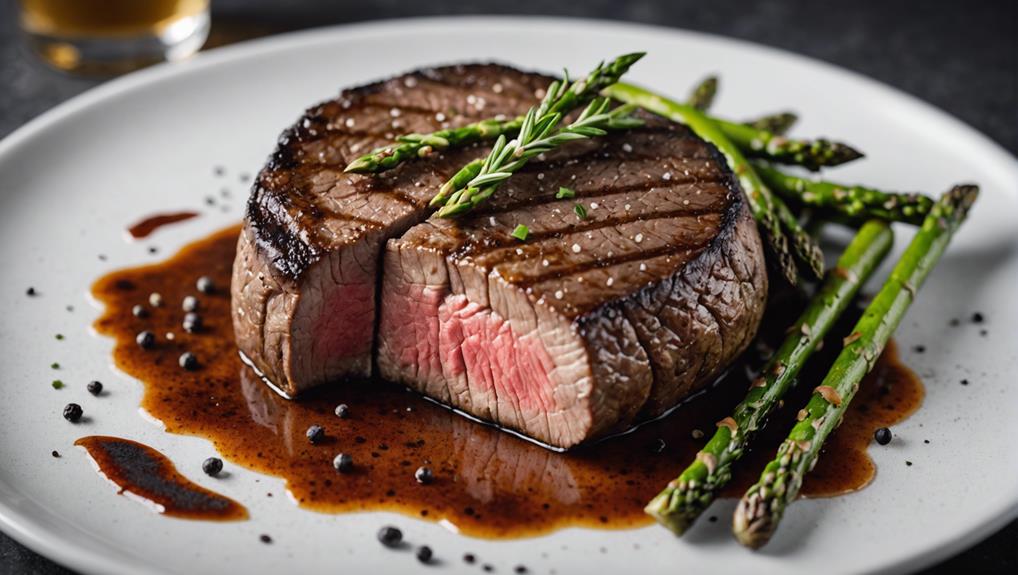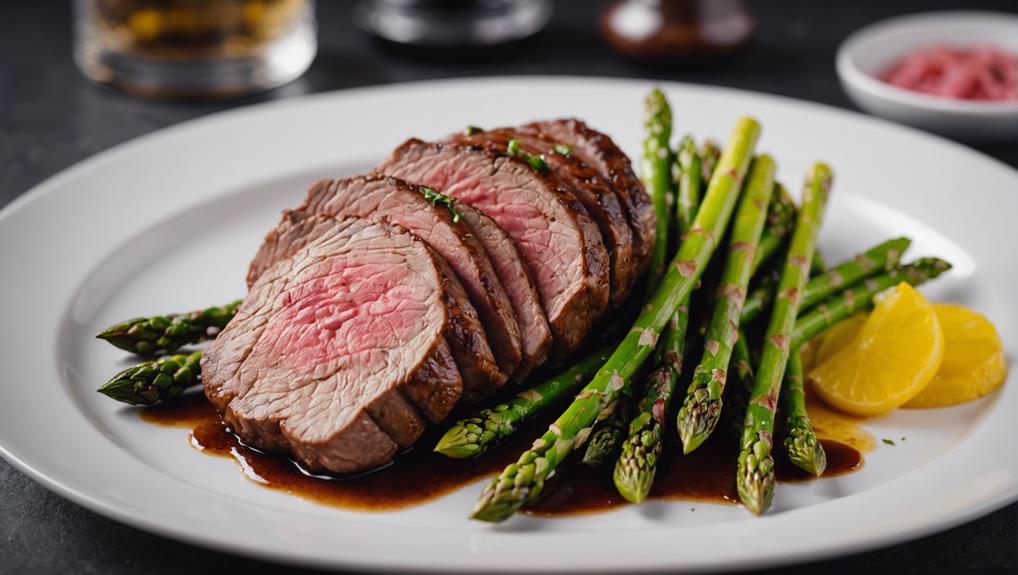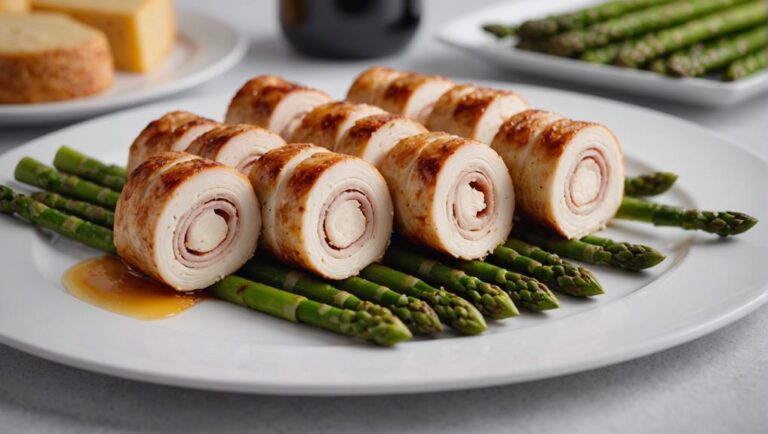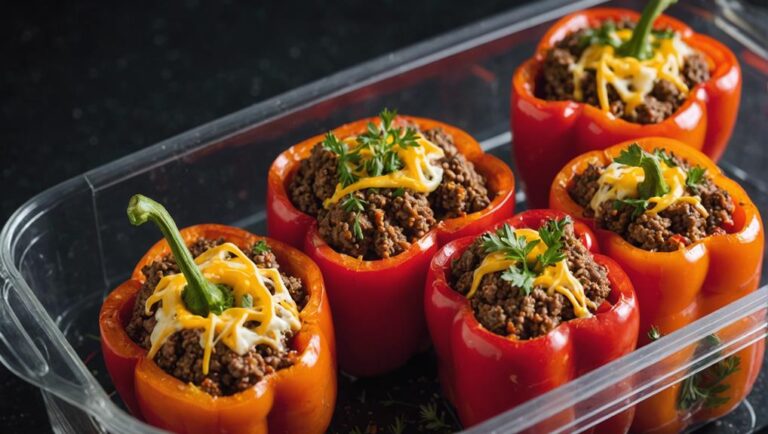Sous Vide Beef Sirloin With Asparagus
Savor the tenderness of Sous Vide Beef Sirloin paired with crisp asparagus. Start by seasoning with salt, pepper, garlic, herbs, and citrus zest for depth. Cook sous vide for precise results, locking in flavors and nutrients. Sear for a crispy exterior, intensifying the beefy richness. The Maillard reaction adds savory notes and a caramelized crust, enhancing the flavor profile. Experience a culinary journey with a harmonious blend of textures and umami richness. This dish embodies the perfect balance of flavors and textures, showcasing the potential of sous vide cooking techniques. Feel the burst of savory juices and lingering satisfaction.
What You Will Learn Here
- Sous vide cooking ensures precise and consistent cooking of beef sirloin.
- Seasoning elements like salt, pepper, and herbs enhance the flavors of the dish.
- Searing the beef sirloin creates a crispy exterior for added depth of flavor.
- Maillard reaction during searing intensifies the beefy flavor profile.
- Asparagus maintains its crispness and freshness when cooked sous vide alongside the beef sirloin.
Sous Vide Cooking Origins

Sous Vide cooking has a rich history that dates back to the 18th century. This French culinary technique involves sealing food in airtight bags and cooking it in a water bath at precise temperatures.
It has since evolved into a popular method known for its ability to deliver consistent, perfectly cooked results.
Sous Vide History
With its roots traced back to the late 18th century, the technique of sous vide cooking originated as a method to preserve foods in a precise and controlled manner. Over time, sous vide has undergone significant evolution, with modern techniques enhancing its efficiency and accessibility.
The benefits of sous vide extend beyond preservation, offering health advantages by allowing food to cook in its own juices, preserving essential nutrients that might otherwise be lost through traditional cooking methods. This method provides a way to cook food precisely and consistently, resulting in dishes that are perfectly cooked throughout.
Sous vide history showcases a culinary innovation that not only revolutionizes cooking processes but also elevates the quality and taste of the final dish.
French Culinary Technique
French culinary technique, known for its precision and attention to detail, has a rich history that intertwines with the origins of sous vide cooking. French cuisine has always been about elevating food through traditional techniques, and sous vide is a perfect example of this with a modern twist. It marries the classic French emphasis on flavors and textures with the innovation of modern tools. Below is a table showcasing some traditional French culinary techniques and how they have been adapted with a modern touch in sous vide cooking:
| Traditional French Technique | Modern Twist in Sous Vide Cooking | Benefits |
|---|---|---|
| Braising | Vacuum-sealing for slow cooking | Enhanced flavors and tenderness |
| Poaching | Precise temperature control | Consistent results every time |
| Marinating | Flavor infusion in vacuum bags | Deeper penetration of flavors |
| Searing | Post-cooking sear for Maillard reaction | Perfect crust without overcooking |
| Deglazing | Utilizing juices for sauces | Intensified sauce flavors |
Precision Cooking Method
Elevating food through precise temperature control and enhanced flavors, sous vide cooking originates from a rich history of traditional French culinary techniques.
This precision cooking method involves vacuum-sealing ingredients in a bag, ensuring that no flavors or nutrients are lost during the cooking process. The sealed bag is then immersed in a water bath set at a specific temperature, guaranteeing consistent heat distribution.
By maintaining a constant temperature throughout the cooking time, sous vide allows for perfectly cooked dishes every time. This method not only enhances the natural flavors of the ingredients but also offers unparalleled control over the cooking process.
Whether you're a seasoned chef or an amateur cook, sous vide's temperature control and cooking time precision can revolutionize your culinary creations.
Key Seasoning Elements

For an exceptional depth of flavor in your sous vide beef sirloin and asparagus dish, the key seasoning elements play an essential role in enhancing every bite. When it comes to seasoning your sous vide creation, the culinary technique of sous vide cooking allows the flavors to penetrate the ingredients thoroughly.
Here are the key seasoning elements to elevate your dish:
- Salt and Pepper: The foundational duo that brings out the natural flavors of the beef and asparagus, enhancing the overall taste profile.
- Garlic and Herbs: Infusing the meat and vegetables with aromatic garlic and fragrant herbs adds layers of complexity to the dish.
- Citrus Zest: A touch of citrus zest, like lemon or orange, brightens up the flavors and adds an invigorating contrast.
- Umami Boosters: Ingredients like soy sauce, Worcestershire sauce, or balsamic vinegar can deepen the savory notes and create a rich umami taste.
Sous Vide Beef Sirloin Variations
Explore the domain of Sous Vide Beef Sirloin Variations to elevate your culinary prowess.
Discover the art of Sous Vide Beef Sirloin Marinade, infusing your meat with flavors that will tantalize your taste buds.
Immerse yourself in the luxurious experience of creating a Herb-Infused Sous Vide Beef dish or indulge in the classic elegance of a Sous Vide Beef Wellington recipe.
Sous Vide Beef Sirloin Marinade
Enhance the flavor of your sous vide beef sirloin by immersing it in a rich marinade that complements its natural juices and tenderness. When preparing your marinade, consider these key points to take your dish to the next level:
- Flavorful Marinade: Choose ingredients like soy sauce, garlic, honey, and herbs to create a robust marinade that will infuse the beef with delicious flavors.
- Cooking Techniques: Experiment with different marinating times to find the perfect balance between flavor absorption and tenderization.
- Temperature Control: Make sure that your marinade is at a safe temperature before adding the beef to prevent any food safety issues.
- Flavor Infusion: Allow the beef to marinate for at least a few hours or overnight to allow the flavors to penetrate the meat deeply.
Herb-Infused Sous Vide Beef Recipe
Infuse your sous vide beef sirloin with a medley of aromatic herbs to elevate its flavor profile and create a delightful culinary experience. Herb-infused sous vide beef takes the tenderness and juiciness of the meat to a whole new level.
Here's how to achieve this innovative dish:
- Select Your Herbs: Choose a combination of fresh herbs like rosemary, thyme, oregano, and sage for a robust flavor profile.
- Prepare the Herb Blend: Finely chop the herbs and mix them with a bit of olive oil, salt, and pepper to create a herb paste.
- Coat the Beef: Rub the herb paste generously over the beef sirloin, ensuring it's evenly distributed.
- Sous Vide Cooking: Vacuum-seal the herb-coated beef and cook it in the sous vide water bath according to your desired doneness.
Enjoy the herb-infused goodness of this sous vide beef recipe!
Sous Vide Beef Wellington Recipe
Curious about how to elevate your sous vide beef sirloin with a delectable twist? Transform your cooking with these innovative Beef Wellington twists and modern presentations:
- Creative Fillings: Experiment with unique fillings like truffle duxelles or foie gras to add a luxurious touch to your sous vide beef Wellington.
- Flavor-Infused Crusts: Enhance your dish with flavored crusts such as parmesan and herb crusts or a mushroom duxelles layer for added depth of taste.
- Sous Vide Perfection: Achieve the ideal doneness by sous viding your beef sirloin before encasing it in puff pastry, ensuring a tender and juicy outcome.
- Serving Sophistication: Elevate your plating game by presenting individual beef Wellington portions for a modern and elegant dining experience.
Searing for Flavor
When you sear your sous vide beef sirloin, you're intensifying its taste by creating a beautiful crust.
This process triggers the Maillard reaction, enhancing the overall flavor profile of the meat.
The crispy exterior achieved through searing adds a delightful depth to each bite.
Intense Searing Enhances Taste
For a mouthwatering depth of flavor in your sous vide beef sirloin, searing it intensely after cooking is vital. The searing benefits go beyond just aesthetics; it plays an essential role in flavor enhancement.
When you sear your perfectly cooked beef sirloin, the high heat causes the sugars and amino acids on the surface to caramelize, creating a complex flavor profile. This process not only adds a rich and savory taste but also enhances the overall sensory experience by providing a contrast in texture.
The Maillard reaction, triggered by searing, reveals a symphony of flavors that elevate your dish to a whole new level. So, don't underestimate the power of a good sear – it's the secret ingredient for a truly unforgettable culinary experience.
Maillard Reaction Boosts Flavor
To enhance the flavor profile of your sous vide beef sirloin, harness the Maillard reaction through a precise and intense searing process. The Maillard reaction is a key cooking technique that occurs when proteins and sugars in the meat react at high temperatures, creating a complex array of flavor compounds.
This browning process not only adds depth but also enhances the overall taste of your beef sirloin. By ensuring a thorough and even sear on the surface of the meat, you're fostering flavor development that will complement the tenderness achieved through sous vide cooking.
The Maillard reaction is essential for maximizing the savory notes and creating a delicious crust that will elevate your dish to new heights of culinary excellence.
Crispy Exterior Adds Depth
Achieving a crispy exterior on your sous vide beef sirloin is essential for adding depth to the flavor profile and enhancing the overall dining experience. When you sear the sous vide beef sirloin after cooking, you create a contrast in textures that elevates each bite.
The crispy texture on the outside not only provides a delightful crunch but also locks in the juices, ensuring a succulent and flavorful steak. The Maillard reaction that occurs during searing enhances the umami notes and intensifies the beefy flavor, resulting in a more complex taste profile.
This extra step not only adds visual appeal with its beautifully caramelized crust but also introduces a depth of flavor that will impress even the most discerning palate.
Final Thoughts
In wrapping up your culinary journey with this Sous Vide Beef Sirloin and Asparagus dish, consider the harmonious blend of flavors and textures that have been meticulously preserved through the sous vide cooking method. Reflections on your taste preferences reveal how this cooking technique has elevated the tenderness of the beef while maintaining the crispness of the asparagus, resulting in a dish that's both succulent and vibrant.
As you savor each bite, you may find yourself appreciating the nuanced flavors that have developed within the vacuum-sealed pouch. The beef sirloin, perfectly cooked to your desired level of doneness, releases a burst of savory juices with every forkful, complementing the earthy notes of the asparagus. The tenderness of the meat, achieved through precise temperature control, melts in your mouth, leaving a lingering umami richness that's simply exquisite.
Frequently Asked Questions
Can I Use Frozen Beef Sirloin for Sous Vide Cooking?
Yes, you can use frozen beef sirloin for sous vide cooking. When cooking frozen meat sous vide, make sure to add extra cooking time. This method preserves the beef's texture, providing a juicy and tender result.
How Long Can I Store Cooked Sous Vide Beef Sirloin?
To store cooked sous vide beef sirloin properly, make sure you refrigerate it within 2 hours. Seal it airtight for up to 3 to 4 days for best flavor retention. Utilize leftovers for salads, sandwiches, or stir-fries.
Is It Necessary to Blanch Asparagus Before Sous Vide Cooking?
When preparing asparagus for sous vide cooking, blanching benefits the overall texture. By briefly boiling the asparagus before vacuum sealing, you can enhance its color, flavor, and tenderness, ensuring a more vibrant and delicious final dish.
Can I Substitute Beef Sirloin With Another Type of Meat?
You can explore meat alternatives like pork tenderloin or chicken breast for sous vide cooking. Adjust cooking techniques and timings accordingly to guarantee excellent results. Experimenting with different cuts can lead to delicious and unique dishes.
Do I Need a Special Tool for Searing Sous Vide Beef Sirloin?
You don't necessarily need a special tool for searing sous vide beef sirloin. Common methods include using a cast-iron skillet or a blowtorch. These alternatives can achieve the desired sear without requiring specialized equipment.
Conclusion
After sous vide cooking your beef sirloin with asparagus to perfection, the tender and flavorful results are truly worth the wait.
The juicy, perfectly cooked meat paired with the crisp, vibrant asparagus creates a harmonious balance of flavors and textures.
Searing the beef adds a delicious caramelized crust, enhancing the overall taste experience.
This sous vide dish is sure to impress your taste buds and leave you craving for more. Enjoy every bite of this exquisite culinary masterpiece.











